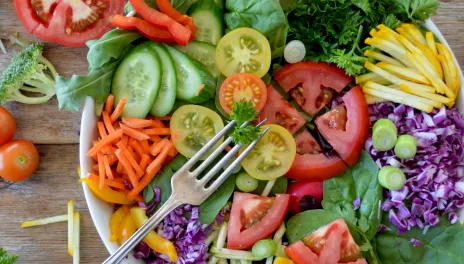Being Healthy Starts by Eating Healthfully: How the Dietary Guidelines for Americans Can Help You
Do you find yourself feeling stressed or tired when you have not even gotten through half of your day?
This is the case for many Americans because they do not follow the Dietary Guidelines. Every five years, new research-based nutrition and health guidelines are released.
The food and beverages that you consume have a profound impact on your health. Currently, 63% of Americans exceed the limit for added sugars, 77% exceed the limit for saturated fat and 75% of Americans have dietary patterns low in vegetables, fruit and dairy.
The overconsumption of sugar and fat, as well as the low intake of fruits and vegetables, has caused the American people’s health to suffer. Six in 10 adults are living with one or more diet-related chronic diseases.
The first step to a healthier you is to follow the four Dietary Guidelines that provide science-based advice to help you, your family and your community, no matter the age, race, socioeconomic status or health status.
- Follow a healthy dietary pattern at every life stage.
- Customize and enjoy nutrient-dense food and beverage choices to reflect personal preferences, cultural traditions and budgetary considerations.
- Focus on meeting food group needs with nutrient-dense foods and beverages, and stay within calorie limits.
- Limit foods and beverages higher in added sugars, saturated fat and sodium, and limit alcoholic beverages.
Keep in mind that it is never too early or too late to improve your food and beverage choices, and to establish a healthful dietary pattern. Each step you take toward eating healthfully can improve your overall health in many ways, including lowering your risk of heart disease, Type 2 diabetes, cancer and obesity.
The core elements that make up a healthful dietary pattern include:
Vegetables of all types
- dark green: broccoli, kale, romaine lettuce, spinach
- red and orange: carrots, sweet potatoes, tomatoes
- beans, peas and lentils: black beans, chickpeas, edamame, pinto beans
- starchy: corn, jicama, white potatoes, yams
Fruits: apples, berries, bananas, melons, oranges, peaches
Grains
- whole grains: brown rice, oats, quinoa, wild rice, whole-wheat bread
- refined grains: white bread, cream of wheat, pasta, white rice
Dairy: cheese, yogurt, milk - *Most choices should be fat-free or low-fat.
Protein Foods:
-
- meats, poultry and eggs: beef, chicken, turkey, pork - *Most choices should be lean or low-fat.
- seafood: clams, crab, cod, salmon, tuna
- nuts, seeds and soy products: peanuts, tree nuts, sunflower seeds, tofu, tempeh - *Nuts should be unsalted.
These nutrient-dense foods and beverages are encouraged because they provide you with vitamins, minerals and other health-promoting components. As long as you are preparing the foods above with little to no added sugar, saturated fat and/or sodium, they are considered nutrient-dense.
Your healthful dietary pattern can meet your wants and needs, food preferences, cultural traditions and budgetary considerations. Most importantly, your healthful dietary pattern based on the Dietary Guidelines for Americans can help promote your health and reduce your risk of disease.
What can you do in your community to promote good health for adults and children?
- Make healthful choices available as snacks and main courses for summer picnics, anniversary, reunions and other parties.
- If you host a buffet, place the salads, vegetables and fruits at the start of the line.
- Promote community outreach through gardening, assistance for healthful food drives and food pantry outreach.
- See Cooking for Groups to learn more about safe food handling for parties and events.
By Ally Jones, Former NDSU Extension Dietetic Intern
Reviewed by Julie Garden-Robinson, Ph.D., R.D., L.R.D., Food and Nutrition Specialist

